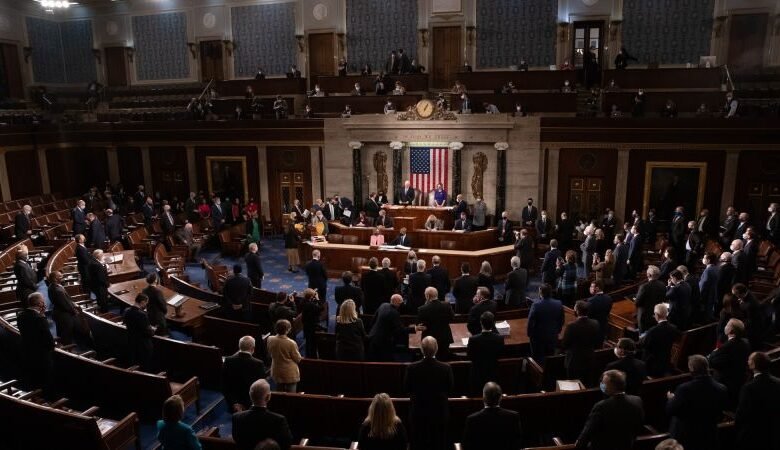Electoral College: How it’s changed this year

A version of this story appeared in CNN’s What Matters newsletter. To get it in your inbox, sign up for free here.
CNN
—
More than 150 million Americans cast ballots for president in November, but it’s 538 electors who actually elect the president when they meet in state capitols every four years.
That archaic process, known as the Electoral College, has endured multiple repeal efforts and one very serious attempt to undermine it in 2020.
But the Electoral College survives.
When electors meet on Tuesday, it’s likely to be a much less dramatic affair in 2024 than it was in 2020, simply because President-elect Donald Trump won the election and is not contesting the results. His Democratic opponent, Vice President Kamala Harris, is also respecting the will of voters this year.
Another contributor to the less dramatic Electoral College meetings this year is that Congress came together in 2022 to pass a bipartisan law, the Electoral Count Reform Act, clarifying how exactly the process should work and making it harder to dispute the results.
Here’s what to know:
When voters cast ballots on Election Day, they are actually selecting a slate of electors tied to that candidate. The winning slate of electors in each state votes for president on December 17.
The 538 electors are equal to the number of US senators (100), House members (435) and three additional electors for voters in Washington, DC. The number of electoral votes each state gets can change after the census every 10 years. It is tied to the number of House members plus two senators each state has in Congress.
Usually, the popular vote winner matches the Electoral College winner, but not always. Twice this century, in 2000 and 2016, the person elected president got the support of fewer American voters than the person who lost the Electoral College.
Warning: The legalese below is going to get a bit complicated. But here’s how things are supposed to work:
► Election Day occurs. By law, presidential elections occur on the Tuesday after the first Monday in November, which was November 5 in 2024.
► Governors issue seven Certificates of Ascertainment. These are seven documents confirming election results from their states and officially naming slates of electors. For 2024, the deadline was December 11, which was six days before the Electoral College meets. These certificates include the names of electors and which presidential candidate they are pledged to support.
Each state’s certificate looks a little bit different. Nevada’s even has a blockchain-powered digital seal. One copy is immediately sent to the National Archives, which posts it online. The other six are kept for the Electoral College meeting.
► Electors meet and vote. The Electoral College meeting occurs on the Tuesday after the second Wednesday in December, which is December 17 this year. Each state’s electors meet in their state and cast their votes. They all sign six copies of a Certificate of Vote that’s attached to six copies of the Certificates of Ascertainment, which are also then sent to the Archives.
In addition to setting those December dates in stone, the new law requires that slates of electors must be selected on Election Day and that procedures for selecting electors, which vary by law from state to state, must be in place before Election Day.
All of that is meant to ward against a repeat of 2020, when Trump and his allies tried to appoint alternate slates of electors. Requiring electors to be selected on Election Day, unless there is something like a major natural disaster, guards against the idea that state legislatures could pick their own electors after Election Day.
Also, while some states have laws that require the electors to support the winner of the popular vote in their state, not all do. Occasionally, electors go rogue and support someone other than their candidate. These are known as “faithless electors.” While there were seven successful faithless electors in 2016, there were none in 2020.
The National Archives has a lot more detail on the process. And the Campaign Legal Center has a rundown of what changed as a result of the Electoral Count Reform Act. But we’re not done yet.
Now things move to the nation’s capital. The six copies of the Certificates of Ascertainment and the Certificate of Vote are sent to various places. The vice president gets one, the chief election officer in each state gets two, the archivist of the US gets two and the federal district judge where the electors meet in their states gets one.
Congress counts the votes. Senators and House members come together on January 6 in the House chamber. Two House members and two senators are appointed as “tellers” who read the vote tallies aloud, state by state.
Lawmakers can object. Lawmakers still have the ability to object to the votes from any state, but the new law requires one-fifth of the lawmakers in each chamber (87 House members and 20 senators) to sign on to an objection, as opposed to four years ago, when it took only one person from each chamber.
If a sufficient number of lawmakers agrees, the two chambers split up to debate the objection. In order to reject electoral votes, a majority vote in both the House and Senate is required.
The vice president, as president of the US Senate, oversees the counting of votes.
But the role has been clarified since four years ago, when Trump’s first vice president, Mike Pence, followed the Constitution and refused Trump’s request to reject votes in key states he lost.
In 2021, Pence’s position was that the vice president could not unilaterally reject electoral votes. Now, the new law explicitly states that the role of the vice president is “ministerial.”
This year, Harris will have to oversee the counting of votes that confirm her defeat. It’s a rare indignity. While Pence oversaw the counting of votes that confirmed he would not be reelected as vice president, Al Gore was the last person to oversee his own presidential loss, back in January 2001.
The new president takes office on January 20, 2025.
https://media.cnn.com/api/v1/images/stellar/prod/gettyimages-1230451908.jpg?c=16×9&q=w_800,c_fill







